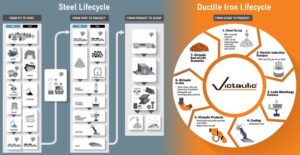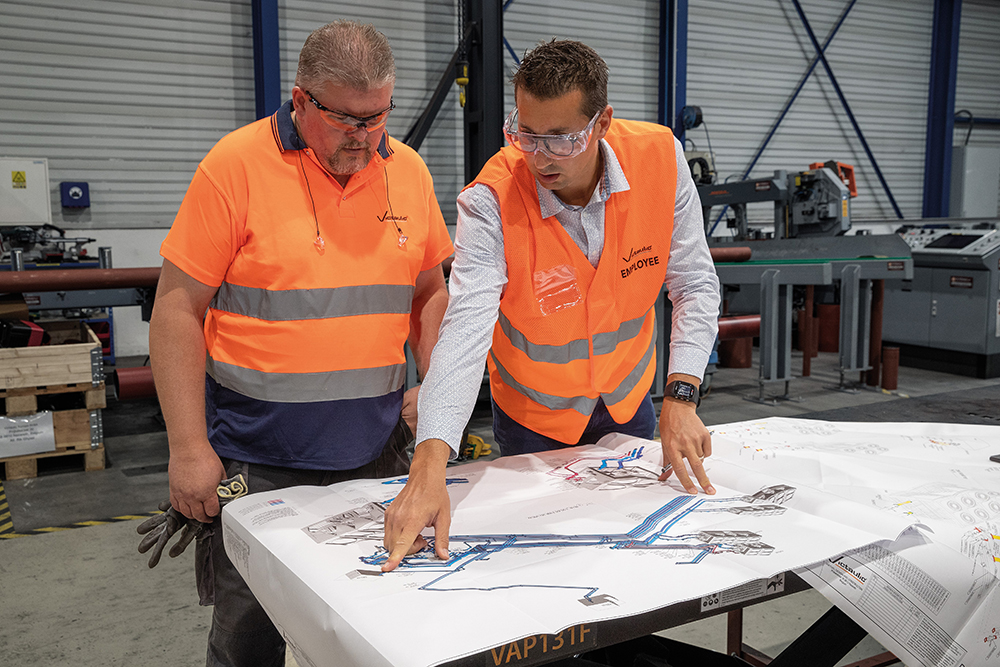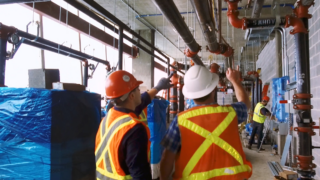View this blog in another language:
Danish Finnish French German Norwegian Swedish
Posted on May 6th, 2024
In part 1 of our Circularity in Construction blog series, we concluded that sourcing circular materials can be a helpful step in achieving project sustainability goals. When we think about the products we choose in a circular way, we are redefining a product’s lifecycle and making room for considering the true environmental impact of our selection. Several sustainability considerations can help in your product selection process:
- Is the production process clean, modern and efficient?
- What are the origins of the source materials?
- Is the installation simple, safe and reliable?
- What will the impact be of using it and will that generate waste?
- What will maintenance look like?
- What will happen at end of life? Will it go into landfill, or can it be recycled or repurposed for use in another product?
In this second part of our Circularity in Construction blog series, we’ll take a closer look at how selecting the right material and design considerations made at the start of a project can further minimize impact and waste, even before setting foot on-site.
Choosing low-impact building materials
Autodesk Construction Cloud’s “Green Construction: A Growing Global Trend” states that the selection and use of building materials that produce less waste during manufacturing can contribute to significantly reducing the environmental impact of construction. Take the selection of pipe joining systems, for example, and the choice between welded steel fittings or grooved ductile iron fittings. The production methods are vastly different. While there are a few ways to produce steel, the dominant steel production method today starts in the ground: the extraction of raw materials (ore and coal) and, subsequently, the waste and loss in biodiversity generated by it. From there heat is applied to produce the steel and reapplied repeatedly eventually forming the final steel product.

The start of our ductile iron process begins where the steel lifecycle ends. The process uses recycled steel, like car body elements, household goods and waste from cutting sheet metal. At Victaulic, our ductile iron products are made using 100% recycled steel, and 100% of our metal shavings and swarf, generated during production, are reused. We also use the cleanest furnace technology — electric induction furnaces reduce carbon dioxide emissions per ton of steel by more than 85% compared to traditional furnaces. This technology is also more electrical- and thermal-efficient compared to primary steelmaking from ores.
And unlike the steelmaking process — transporting raw materials across the globe — we manufacture close to the markets we serve, and we are committed to sourcing our scrap steel locally allowing us to quickly serve customers while cutting transportation emissions.
Minimizing impact in the design stage
According to the UK Green Building Council’s “Insights on how circular economy principles can impact carbon and value”, standardization/modularization, when twinned with off-site methods that reduce waste, can reduce upfront carbon. This means that reducing impact can start with making informed decisions in the design stage of a construction project. Autodesk Construction Cloud also believes in this approach. According to their Digital Sustainability Research, 53% of construction professionals believe prefabrication is the approach with the greatest potential to reduce the industry’s carbon emissions. Next to recommending prefabrication as a solution to reduce emissions, they also highly recommend the use of Building Information Modeling (BIM) to avoid errors and waste.
At Victaulic, we also leverage fabrication-ready BIM models, when possible, to provide accurate information throughout the coordination phase and ultimately to increase constructability. Here’s why:
BIM helps to identify potential clashes up front, providing a host of project benefits. BIM software creates a realistic and intelligent 3D model of a building. Architects, engineers, and contractors can collaborate in real time on the same model, helping to ensure that everyone is in sync and their plans are compatible. When one person makes a change, everyone can see the impact on their area. BIM helps avoid rework on-site, reduces deliveries and waste, avoids over-ordering of material, improves productivity, and enables faster installation opportunities on-site.
BIM also supports lifecycle assessment and provides insights into operations, maintenance, and end-of-life resolution. BIM models can integrate with Internet-of-Things sensors to allow optimization of space utilization, energy use, maintenance scheduling and repairs, and assessment for upgrades. And at end of life, it facilitates deconstruction — with greater reuse, repurposing, and recycling of building components — in place of demolition.
Along with BIM, standardization is a key strategy of ours for enabling circularity in construction and reducing waste. Standardized products increase productivity on-site while reducing construction time, leading to a reduction in construction site emissions. Choosing grooved pipe joining technology simplifies standardization and allows for easier prefabrication off-site, cutting construction time, manpower and waste. Grooved pipe spools have the added value of shipping flat, making transportation much more efficient — you can ship up to three times as much per load compared to 3D welded steel spools.
Selecting low-impact materials and using BIM, combined with prefabrication and modularization, are all effective preconstruction strategies to reduce emissions, waste and risk. Tune in for part 3 of our Circularity in Construction series to learn how to further reduce impact and waste during jobsite construction.
Want to reduce the environmental impact of your next project? Get in touch for more information about selecting circular products, BIM, prefabrication, and other ways Victaulic can support the achievement of your next project’s sustainability goals.



